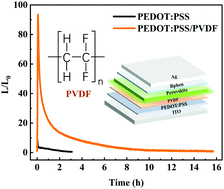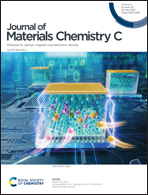Interface energy level alignment and improved film quality with a hydrophilic polymer interlayer to improve the device efficiency and stability of all-inorganic halide perovskite light-emitting diodes
Abstract
Interface modification is critical for improving the device performance of perovskite light-emitting diodes (PeLEDs) based on an all-inorganic halide perovskite, CsPbBr3. Here, we show that inserting a thin hydrophilic polymer interlayer at the perovskite/hole transport layer (HTL) interface leads to the energy level alignment at this interface and the improved film quality of the perovskite layer. As a result, the turn-on voltage of the PeLEDs is reduced and the current efficiency is notably improved. Furthermore, the device stability is greatly enhanced by the polymer interlayer. The underlying mechanisms for the improvements in the device performance by the polymer interlayer are explored using different techniques and by comparison of different polymers. This work sheds light on the function of the polymer interlayer in modifying the device efficiency and stability of the PeLEDs.



 Please wait while we load your content...
Please wait while we load your content...